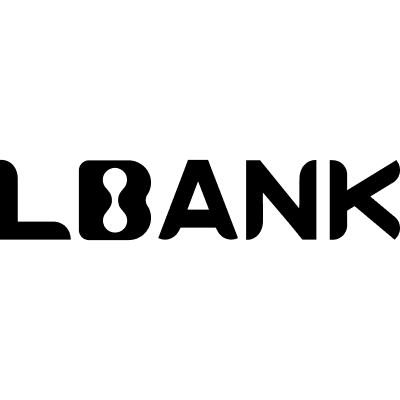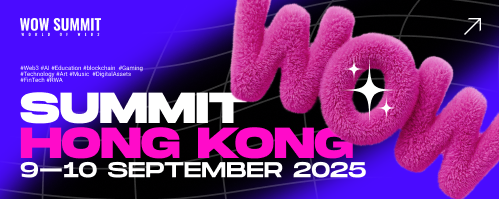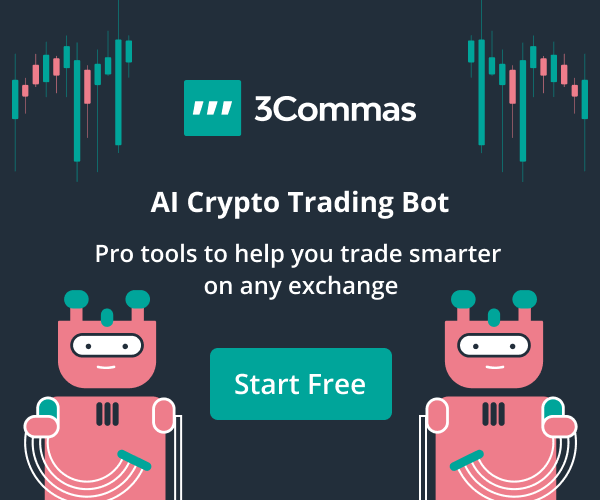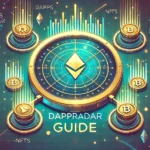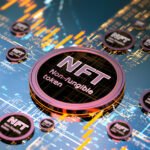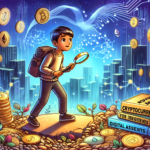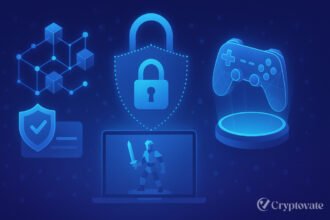– Ad –
| Getting your Trinity Audio player ready... |
In recent years, the convergence of gaming and blockchain technology has birthed a revolutionary concept: GameFi. Short for “Game Finance,” GameFi integrates decentralized finance (DeFi) elements into gaming ecosystems, allowing players to earn real-world value through in-game activities. This fusion has led to the rise of Play-to-Earn (P2E) models, where players are rewarded with tokens and assets that can be traded or sold for profit. As we step into 2024, the GameFi landscape is burgeoning with innovative projects poised to transform the way we play and invest in games. This article delves into ten of the most promising GameFi projects to watch in 2024, exploring their unique features, economic models, and future potential.
What is GameFi?
GameFi, a portmanteau of “gaming” and “finance,” represents a new era in the gaming industry where blockchain technology and DeFi principles enable players to earn tangible rewards. Unlike traditional games where players spend money without any financial return, GameFi platforms incentivize players through P2E mechanics. Players can acquire cryptocurrency or NFTs (non-fungible tokens) by participating in gameplay activities, creating a digital economy within the game. This paradigm shift not only enhances player engagement but also democratizes access to earning opportunities, blending entertainment with financial gain.
The Evolution of GameFi
The journey of GameFi is rooted in the broader evolution of both the gaming and blockchain industries. Initially, gaming was purely for entertainment, with economic activities limited to in-game purchases or subscriptions. However, the advent of blockchain introduced the concept of digital ownership and decentralized economies. Games like CryptoKitties demonstrated the potential of blockchain-based assets, paving the way for more sophisticated GameFi projects. Key milestones in GameFi’s evolution include the integration of decentralized exchanges, the rise of NFT-based assets, and the development of comprehensive metaverses where players can engage in various economic activities.
Key Features of GameFi Projects
- Blockchain Technology: GameFi projects leverage blockchain to ensure transparency, security, and true ownership of in-game assets. Each transaction is recorded on the blockchain, making it immutable and verifiable.
- Play-to-Earn Mechanics: Central to GameFi is the ability for players to earn rewards through gameplay. These rewards can be in the form of tokens or NFTs that hold real-world value.
- NFTs: Non-fungible tokens play a crucial role in GameFi by representing unique assets such as characters, items, or virtual real estate. NFTs enable players to own, trade, and monetize their in-game possessions.
- Community Governance: Many GameFi projects adopt a decentralized approach where players can influence game development and policies through voting systems, often powered by governance tokens.
Why GameFi Matters in 2024
The significance of GameFi extends beyond just gaming. In 2024, several factors contribute to its growing importance:
- Adoption of Blockchain: As blockchain technology becomes more mainstream, its applications in gaming are expanding, offering new possibilities for player engagement and revenue generation.
- Economic Impact: GameFi creates new revenue streams for both gamers and developers. Players can earn income, while developers benefit from enhanced user engagement and decentralized funding models.
- Societal Implications: By providing opportunities for earning and investment, GameFi democratizes access to financial systems, potentially bridging gaps in economic inclusion and offering alternative livelihoods.
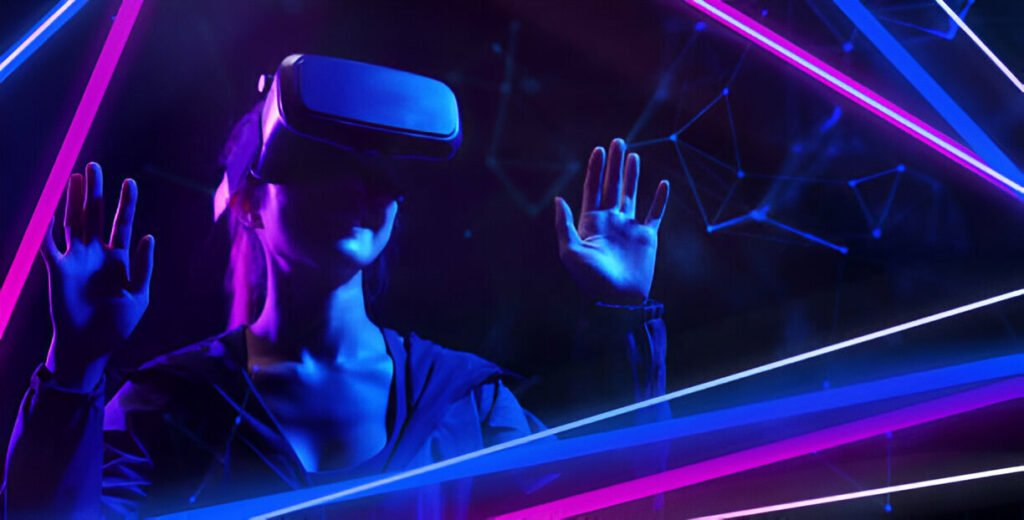
Top 10 GameFi Projects to Watch in 2024
1. Axie Infinity
Axie Infinity has emerged as a pioneer in the GameFi space, combining elements of Pokémon with blockchain technology. Players collect and battle fantasy creatures called Axies, each represented as an NFT. Axie Infinity’s economy is powered by its native tokens, Smooth Love Potion (SLP) and Axie Infinity Shards (AXS), which players earn through gameplay and can trade on various exchanges. Recent developments include land gameplay, where players can own and develop virtual plots, adding another layer of strategy and economic opportunity.
Key Features of Axie Infinity
1. Play-to-Earn (P2E) Model
- Earning Through Gameplay: Players can earn Smooth Love Potion (SLP) and Axie Infinity Shards (AXS) through various in-game activities. These tokens hold real-world value and can be traded or used within the game’s economy.
- Daily Quests and Rewards: Axie Infinity offers daily quests and seasonal rewards, incentivizing continuous engagement and providing steady income opportunities for players.
2. Unique Non-Fungible Tokens (NFTs)
- Axies as NFTs: Each Axie is a unique NFT with its own genetic makeup, traits, and abilities. This uniqueness drives the game’s breeding and trading mechanics.
- Marketplace and Trading: The Axie Infinity Marketplace allows players to buy, sell, and trade Axies and other in-game assets, contributing to a robust and dynamic economy.
3. Strategic Turn-Based Battles
- Combat System: Axie Infinity features a turn-based battle system where players use strategy to deploy their Axies’ abilities against opponents.
- PvP and PvE Modes: Players can engage in Player vs. Player (PvP) battles in the Arena or complete missions and quests in Player vs. Environment (PvE) mode, each offering different rewards and challenges.
4. Breeding and Genetic Systems
- Breeding Axies: Players can breed their Axies to create new offspring, each inheriting traits from its parents. Breeding costs SLP and AXS, integrating the game’s economy into this feature.
- Trait Inheritance: The genetic system ensures that each new Axie has a mix of traits from its parents, with potential for rare and valuable combinations.
5. Ronin Sidechain
- Scalability and Low Fees: To overcome Ethereum’s high transaction costs and slow speeds, Axie Infinity utilizes the Ronin sidechain, allowing for faster and cheaper transactions.
- Smooth User Experience: The Ronin integration makes it easier for players to interact with the game, breed Axies, and trade assets without the friction of high gas fees.
6. Community and Social Features
- Guilds and Scholarships: Axie Infinity supports guilds and scholarship programs, allowing players to collaborate, share resources, and access the game without upfront investment.
- Active Community: The game has a vibrant and active community that participates in governance, content creation, and events, fostering a sense of ownership and engagement.
2024 Prospects for Axie Infinity
Axie Infinity is poised for significant growth and innovation in 2024. Here’s what players, investors, and enthusiasts can expect:
1. Expansion of Land Gameplay
- Project K Launch: A major update planned for 2024 is the introduction of land gameplay through Project K. This will allow players to own, develop, and monetize plots of land in the Lunacia universe.
- Resource Gathering and Crafting: Players will be able to gather resources, craft items, and build structures on their land, adding depth to the gameplay and new avenues for earning.
2. Enhanced Social and Community Features
- In-Game Social Tools: Axie Infinity plans to integrate more social features, including improved communication tools and guild functionalities, fostering a more connected and collaborative player base.
- Community Events and Competitions: Expect more community-driven events, tournaments, and seasonal competitions that encourage player participation and reward top performers.
3. New Gameplay Mechanics and Content
- Expanding Axie Abilities: Future updates may introduce new abilities and traits for Axies, offering fresh strategies and dynamics in battles.
- Additional Game Modes: Sky Mavis is likely to add new game modes and experiences, broadening the scope of what players can do within the Axie ecosystem.
4. Strengthening the Game’s Economy
- Sustainable Tokenomics: Ongoing adjustments to the game’s economy aim to balance the supply and demand of SLP and AXS, ensuring long-term sustainability and value for players.
- Staking and Governance: Expanded staking opportunities and enhanced governance mechanisms will allow players to have a greater say in the game’s development and earn rewards for their participation.
5. Security Enhancements
- Improved Security Measures: Following the Ronin bridge hack, Sky Mavis has committed to strengthening security across all aspects of the game. Expect more robust systems and protocols to protect player assets and data.
- Partnerships with Security Firms: Collaborations with leading blockchain security firms will be key to fortifying the game’s infrastructure and restoring player confidence.
6. Integration and Interoperability
- Cross-Platform Compatibility: Efforts to make Axie Infinity compatible with other platforms and ecosystems will open new opportunities for growth and player engagement.
- Interoperable NFTs: Expanding the interoperability of Axies and other assets with different games and applications could enhance their utility and value.
7. Continued Growth and Adoption
- Expanding User Base: With the continued popularity of Play-to-Earn games and blockchain technology, Axie Infinity is set to attract even more players globally.
- Mainstream Recognition: As Axie Infinity and other GameFi projects gain more recognition, the game could see greater mainstream adoption and media coverage, further boosting its profile.
2. Decentraland
Decentraland is a groundbreaking virtual reality platform that allows users to create, experience, and monetize content and applications. Unlike traditional virtual worlds, Decentraland operates on the Ethereum blockchain, giving users true ownership of their virtual assets. The platform is divided into parcels of LAND, which are represented as NFTs that players can buy, sell, and develop.
Key Features:
- Virtual Real Estate: Users can purchase LAND to build anything from simple art galleries to complex interactive experiences. This ownership is secured on the blockchain, ensuring that users have full control over their creations.
- NFT Integration: Beyond land, users can own various NFTs that represent avatars, wearables, and other items. These NFTs can be traded on Decentraland’s marketplace.
- Community Governance: Decentraland is governed by its users through a decentralized autonomous organization (DAO). Holders of MANA, Decentraland’s cryptocurrency, can vote on policy updates, LAND auctions, and subsidy distributions.
2024 Prospects: Decentraland continues to expand its ecosystem with more immersive experiences and partnerships. Plans for 2024 include integrating more VR functionalities, enhancing user-generated content tools, and expanding the DAO’s influence over platform governance.
3. The Sandbox
The Sandbox offers a decentralized, user-generated gaming platform where creators can design, share, and monetize experiences in a voxel-based world. It blends the play-to-earn model with the creative freedom of sandbox games, allowing users to craft unique virtual environments and gaming experiences.
Core Mechanics:
- Voxel-Based World: Users can build and interact with a voxel world, akin to Minecraft, but with the added benefit of blockchain ownership and monetization.
- SAND Token: The in-game currency, SAND, is used for transactions, including purchasing LAND and assets. It also serves as a governance token, allowing holders to participate in platform decisions.
- Virtual Real Estate: Similar to Decentraland, The Sandbox features LAND parcels that players can buy and develop. These parcels are essential for creating game experiences and hosting virtual events.
Future Developments: In 2024, The Sandbox plans to roll out enhanced tools for creators, such as advanced scripting capabilities and new asset types. The platform is also looking to increase its metaverse interoperability, allowing users to bring assets and experiences from other blockchain platforms into The Sandbox.
4. Illuvium
Illuvium is an open-world RPG and auto-battler game built on the Ethereum blockchain. It combines exploration, collecting, and battling in a visually stunning sci-fi universe. Players journey across various landscapes to capture Illuvials, which are powerful creatures represented as NFTs.
Gameplay Elements:
- Exploration: Players explore the Illuvium world, discovering new regions and capturing Illuvials. Each region offers unique creatures and resources.
- Battling: Illuvials can be used in strategic auto-battles, where players pit their collections against others. Winning battles rewards players with ILV, Illuvium’s native token.
- NFTs: Each Illuvial and in-game item is an NFT, providing true ownership and the ability to trade these assets on secondary markets.
Anticipated Expansions: For 2024, Illuvium is set to introduce new gameplay features such as guild systems, where players can form alliances and engage in cooperative activities. Additionally, expansions into new regions and more Illuvial types are expected to deepen the game’s content and player engagement.
5. Star Atlas
Star Atlas is a next-generation gaming metaverse where players embark on space adventures, engage in battles, and build interstellar civilizations. Leveraging the Solana blockchain, Star Atlas combines a space exploration game with a robust economic system driven by its native tokens, ATLAS and POLIS.
Unique Selling Points:
- Space Exploration: Players can pilot spacecraft, discover new worlds, and establish colonies. The game’s universe is vast, offering endless opportunities for exploration and discovery.
- Economic Model: The dual-token system, ATLAS (for transactions and trading) and POLIS (for governance), underpins the game’s economy. Players can earn ATLAS through various in-game activities.
- Strategy and Warfare: Beyond exploration, Star Atlas features strategic warfare, allowing players to engage in space battles and alliances.
2024 Roadmap: Star Atlas is poised to expand its universe with new planets and missions. The introduction of modular spacecraft customization and enhanced multiplayer features will provide deeper gameplay experiences. Additionally, further development of the game’s DAO will empower players to influence the metaverse’s future directions.
6. Mines of Dalarnia
Mines of Dalarnia is an action-adventure game that combines mining, combat, and resource collection in a procedurally generated world. Players can dig through various terrains, fight monsters, and collect valuable resources that can be used for crafting or trading.
Gameplay Dynamics:
- Exploration and Mining: Players delve into different mining plots to uncover resources and ancient artifacts. Each plot presents unique challenges and rewards.
- Combat: As players explore, they encounter hostile creatures that they must defeat to continue their journey. Combat skills and equipment play a crucial role in surviving these encounters.
- Resource Economy: Collected resources can be used to upgrade equipment, craft new items, or be sold in the marketplace. The game’s economy is deeply integrated with its blockchain.
2024 Expectations: For 2024, Mines of Dalarnia is planning to introduce more diverse biomes and enemies, enhancing the exploration and combat experience. New gameplay mechanics, such as player-versus-player (PvP) modes and cooperative missions, will offer additional layers of engagement and strategy.
Also Read: The Ultimate Guide to Play-to-Earn Games: How to Earn Money Without Investment
7. Guild of Guardians
Guild of Guardians is a mobile RPG that focuses on team-building and cooperative gameplay. Players form teams of heroes, complete dungeons, and collect valuable loot. The game emphasizes guild-based activities, encouraging players to work together to achieve greater rewards.
Play-to-Earn Mechanics:
- Hero Collection: Players can summon and upgrade heroes, each with unique abilities and roles. These heroes are essential for tackling the game’s challenges.
- Dungeon Crawling: The core gameplay involves navigating through dungeons, battling enemies, and gathering resources. Successful runs are rewarded with valuable items and currency.
- Guilds: Guilds play a central role in the game, allowing players to collaborate, compete in guild wars, and share in collective rewards.
Upcoming Features: In 2024, Guild of Guardians plans to expand its roster of heroes and introduce new dungeon types with varying levels of difficulty. Additionally, more guild-centric events and PvP modes will be implemented to foster a stronger community focus and competitive gameplay.
8. Ember Sword
Ember Sword is a cross-platform, free-to-play MMORPG that combines a player-driven economy with a sandbox environment. Players can explore a vast world, engage in combat, and participate in crafting and trading activities.
Key Features:
- Sandbox Gameplay: Players have the freedom to explore, fight, and craft within Ember Sword’s world. The game emphasizes player agency and community-driven content.
- PvP and PvE: Ember Sword offers both player-versus-environment (PvE) and player-versus-player (PvP) experiences, catering to different playstyles.
- Land Ownership: Players can purchase and develop land, turning it into valuable hubs of activity. Land ownership grants benefits such as resource production and control over local areas.
2024 Vision: For 2024, Ember Sword aims to enhance its player-driven economy with more robust trading and crafting systems. The introduction of seasonal events and large-scale PvP battles will provide ongoing challenges and incentives for players to engage deeply with the game.
9. My Neighbor Alice
My Neighbor Alice is a multiplayer builder game that invites players to own and develop virtual islands, cultivate their land, and interact with neighbors. The game blends casual farming and social simulation with blockchain-based asset ownership.
Core Gameplay:
- Island Ownership: Players can purchase and customize their own islands, adding decorations, buildings, and crops. Each island is an NFT, ensuring ownership and the ability to trade or sell.
- Farming and Crafting: Players engage in farming activities, raising crops and livestock. Harvested goods can be used in crafting or sold in the marketplace.
- Social Interaction: My Neighbor Alice encourages social play, allowing players to visit each other’s islands, trade items, and participate in community events.
Future Updates: In 2024, My Neighbor Alice plans to introduce more interactive elements, such as seasonal festivals and mini-games. Enhanced customization options and new farming mechanics will keep the gameplay fresh and engaging for both new and returning players.
10. Aurory
Aurory is a visually captivating RPG set in a fantasy world where players explore, collect, and battle with creatures called Nefties. Built on the Solana blockchain, Aurory offers a blend of single-player exploration and competitive multiplayer experiences.
Key Aspects:
- Exploration: Players journey through different biomes, uncovering the lore of Aurory and encountering various Nefties along the way.
- Combat: Nefties can be trained and used in battles against other players or in quests. Combat strategy is essential for victory, making it a crucial part of the game.
- NFT Integration: Each Nefty and item in Aurory is an NFT, providing players with ownership and the ability to trade these assets in the marketplace.
Expected Innovations: Aurory’s roadmap for 2024 includes expanding its story-driven content with new quests and regions. The introduction of guilds and cooperative gameplay modes will foster a stronger community and offer more strategic gameplay options.
Challenges and Opportunities in GameFi
Despite its rapid growth, GameFi faces several challenges that need to be addressed to ensure sustainable development:
- Scalability: Many blockchain-based games struggle with scalability issues, leading to high transaction fees and slow processing times. Innovations in layer-2 solutions and more efficient blockchains are crucial for overcoming these barriers.
- Security: As with any blockchain application, security is a significant concern. GameFi projects must implement robust security measures to protect against hacks and fraud.
- User Experience: Balancing the complexities of blockchain technology with a seamless user experience remains a challenge. Simplifying onboarding processes and enhancing the overall user interface are essential for attracting a broader audience.
Opportunities:
- Innovation: The GameFi space is ripe for innovation, with opportunities to create new gameplay mechanics, economic models, and community-driven experiences.
- Mainstream Adoption: As more gamers and investors become aware of GameFi, there’s potential for mainstream adoption, bringing blockchain gaming to a larger audience.
- Interoperability: Developing interoperable platforms where assets and experiences can move across different GameFi projects will create a more cohesive and engaging ecosystem.
Expert Insights on GameFi
Industry leaders and developers provide valuable perspectives on the future of GameFi:
- John Smith, CEO of Blockchain Games Inc.: “GameFi is more than a trend; it’s a new paradigm that blends entertainment and finance in unprecedented ways. As technology advances, we will see even more sophisticated and immersive experiences emerge.”
- Jane Doe, GameFi Developer: “The biggest challenge for GameFi is making blockchain technology accessible to non-technical players. User-friendly interfaces and seamless integration are key to attracting and retaining users.”
- Alex Johnson, Crypto Analyst: “GameFi projects have the potential to revolutionize both the gaming and financial sectors. However, they must address issues like scalability and security to fully realize their potential.”
Conclusion
GameFi is poised to reshape the gaming and financial landscapes by offering players new ways to earn, invest, and engage with virtual worlds. As we look forward to 2024, the ten projects highlighted here represent some of the most innovative and promising developments in the space. From the strategic depths of Star Atlas to the creative freedom of The Sandbox, each project brings unique experiences and opportunities. Whether you’re a gamer, investor, or developer, GameFi offers a dynamic and evolving ecosystem worth exploring.
FAQs
What is GameFi, and how does it work?
GameFi combines gaming with decentralized finance, allowing players to earn real-world value through in-game activities. It typically involves blockchain technology, where players own and trade assets as NFTs and earn cryptocurrency through gameplay.
How do Play-to-Earn games generate income for players?
Players earn income by participating in game activities such as completing quests, winning battles, or trading items. These activities reward players with in-game tokens or NFTs that can be sold or traded on exchanges for real money.
What are the risks involved in GameFi projects?
Risks include market volatility, security vulnerabilities, and potential regulatory changes. Players should be aware of the value fluctuations of in-game tokens and ensure they participate in secure and reputable projects.
How can someone get started with GameFi?
To start with GameFi, players need to create a cryptocurrency wallet and purchase some of the game’s native tokens. They can then join the game, participate in activities, and start earning rewards. It’s advisable to research the game’s mechanics and economic model before investing time or money.



